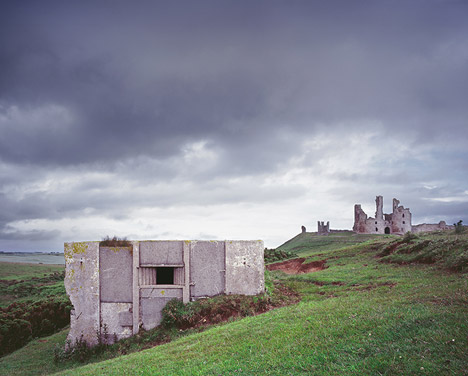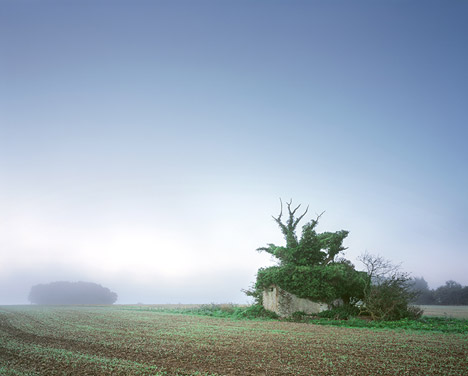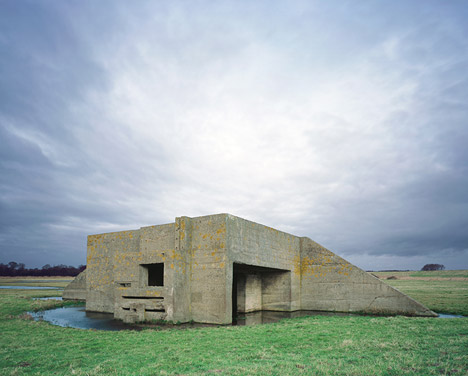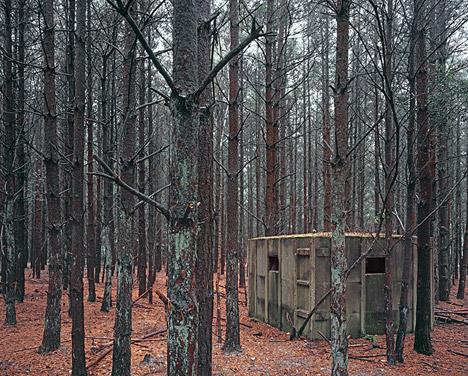Richard Brine photographs the concrete "pillboxes" left over from the war
Photo essay: 70 years after the second world war ended, there are still over 6,000 defensive structures along Britain's coastline. Photographer Richard Brine has been documenting them (+ slideshow).
The series, entitled Defensive Structures in the British Landscape, depicts the field defences installed between 1940 and 1941 when the country was on the brink of invasion by Germany. They were popularly known as pillboxes, because of their cylindrical and hexagonal shapes.
"To describe how these curious structures sit in the landscape has always been my intent, but in doing so I wanted to convey a sense of place, and capture the atmosphere of their environment," explained Brine, who is currently showing the images in an exhibition at London's Architectural Association.
This essay, written by Dominic Bradbury to accompany the exhibition, tells the story behind the small yet resilient buildings.
Our countryside and coastline are populated with an enigmatic and eccentric collection of buildings that are now nearly 75 years old. Partly forgotten and often ignored, the old pillboxes and defensive emplacements built across Britain in 1940 and 1941 represent and record an extraordinary achievement.
In the space of just a short number of months thousands of these buildings were built across the country in a desperate attempt to prepare for the very real threat of German invasion.

A Directorate of Fortifications and Works drew up a range of pillbox designs that could be built quickly and easily right across the country. These designs were ingenious and functional, but also possessed a sculptural sense of abstraction.
The fact that thousands still survive right across Britain points to how well they were designed and how robust was their construction. Yet there was also a degree of localism and amateurism to many of these buildings, with the character of these buildings shaped by local materials and the abilities of local soldiers, labourers and volunteers to turn the designs into hard reality.
Some were made with brick and some were woven into the fabric of existing buildings. Most were made with reinforced concrete according to a pattern book laid down by the Directorate, but even the mix of concrete varied depending on the availability of sand, cement and shingle. This gave variation to the appearance of pillboxes, while they were also shaped by context and the land itself, with some standing out in the landscape as obvious sentinels and others partly submerged within fields or cliffs.

The sheer scale of the enterprise was staggering, with around 28,000 separate structures built across the countryside with over 6,000 still remaining. Most are neglected and many are crumbling, yet they remain a distinct and common presence across the British landscape.
They are buildings that we stumble upon on cliff tops and beaches, brought down by coastal erosion but still surviving the onslaught of the waves for decades at a time. Others crop up in surprising and unexpected places, where the line of defence appears unclear or confused to us now. Yet at the time they represented strategic thinking turned to reality upon future battlefields.
Today, these buildings are resonant and full of meaning. They are sculptural and engaging in themselves and carry the poignancy of relics and lost structures. They become all the more dramatic when they sit within wild, exposed and untamed rural panoramas.
Yet they are also emblematic of a desperate enterprise that connects with what we sometimes call Britain's finest hour – a time when the country struggled to come together to stave off the threat of defeat, helped by its island geography. The country itself became a fortress and the pillboxes and embrasures were our first line of defence.

These small, obscure buildings have a poetic importance, combining and encapsulating many themes that still have the power to arrest and engage us. They are poignant reminders of many aspects of our own identity and national character and their increasingly vulnerability, after so many years of ‘service', lends them a particular pathos.
Nature is doing her best to reclaim these buildings at last, with their concrete shells juxtaposed with swallowing sand and choking bushes, vines and undergrowth. They serve, then, as metaphors of both victory and gradual decline at one and the same time.
Given their history and depth of meaning, it is no wonder that these strange, seductive structures captured the attention of architectural photographer Richard Brine.
Yet Brine has not sought to simply catalogue or document these buildings out of a sense of historical duty. There is a richer purpose to Brine's photographs, which aim to encapsulate some of the wider themes that these buildings suggest.

Brine concentrates on the place of these buildings within vivid and powerful landscapes and their particular resonance within a very specific local context – whether on the Norfolk coast or the Oxfordshire countryside.
In doing so, Brine uncovers individual stories that bring together aspects of architecture, planning and local endeavour. These stories build into a striking collection of engaging images that coalesce into a much larger and thought provoking narrative.